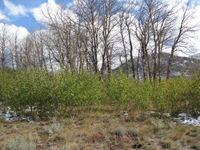Grazing animals and a lack of wildfires are the likely culprits in the declining health of aspen tree stands in and around the Wood River Valley.
"There's a long-term concern that we're losing aspens because of a lack of regeneration," Sawtooth National Recreation Area wildlife biologist Robin Garwood said in an interview.
Aspen trees are a key ingredient in a healthy forest ecosystem, providing nesting habitat for numerous species of birds, and food and cover for grouse, deer and elk.
Garwood explained that aspens regenerate through a process called "suckering," in which new trees sprout from the root system of the entire stand. This process is stimulated by disturbances to the other trees, including the loss of older members of a stand.
As the older trees disappear, they cease to suppress a hormone that spurs the growth of "suckers" up out of the roots.
However, without fire to remove older trees, a problem arises.
"It's generally thought that fire suppression is hampering aspen growth around the West," Garwood said.
Last autumn, the SNRA carried out a prescribed burn in the Pole Creek valley, which divides the Boulder Mountains from the White Cloud Mountains. The deteriorating aspen stands are on the north side of Galena Summit and south of Smiley Creek Lodge.
As a result of such fires, Garwood said, a large "flush of suckering" occurs.
However, with one of the wettest summers on record this year, there were not only no significant wildfires in the area, but the rainfall impeded any effort to conduct prescribed burns.
In addition to the lack of flames, aspen growth has also been hampered by grazing animals, including sheep, deer and elk.
"The livestock and ungulates eat the young trees just coming up so they don't get a good start," Garwood said. "They eventually just turn into shrubs."
As well, sheep trampling through and bedding down in aspen stands also keeps young trees from growing.
To combat that, Garwood said, the SNRA instructs permitted ranchers to stay away from certain areas and has begun erecting small fenced-in areas to keep deer away from stands.
Garwood said the decline in the stands is subtle, making it difficult to quickly discern those in trouble. She said that if the ground looks like it's been "browsed over" or if there is no growth in the understory, but only older trees, then the stand is unhealthy. Another indicator that the aspens are having trouble regenerating is the presence of lots of pine trees mixed into the stand.
She said a healthy aspen stand has a number of thin trees 5 to 6 feet tall.
"We're plugging away a little at a time," Garwood said. "On a scale to 10, my concern over the trees is about an 8."
Jon Duval: jduval@mtexpress.com


 Aspen trees regenerate well after fires. In this photo, new, aspens grow next to older trees. Photo by
Aspen trees regenerate well after fires. In this photo, new, aspens grow next to older trees. Photo by



































